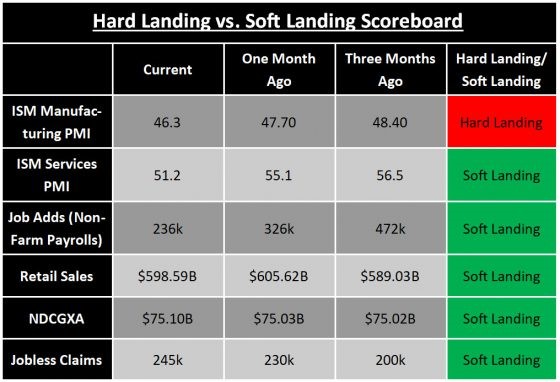Hard or Soft? That is the Question
- Hard or Soft? That is the Question
- ETF Talk: Proving the Market’s ‘Mettle’ With This ETF
- Winning the Investing Race
- Your Mind is Not for Rent
***********************************************************
Hard or Soft? That is the Question
Hard landing or soft landing? It’s one of the most important debates in the market right now, as the answer to that question likely determines whether the next 10% in stocks is higher or lower.
Yet, despite the importance of this issue, I haven’t seen any sort of comprehensive “scoreboard” on which outcome is more likely. And so, when something that you need doesn’t exist, it’s incumbent upon you to create it.
That is, in fact, what we have done, and by “we” I am referring here to myself and my “secret market insider,” i.e., my superb and anonymous Wall Street colleague that feeds me the information used in our daily market briefing, Eagle Eye Opener.
This scoreboard will help us keep track of the key data points that will dictate whether we get a hard economic landing (bearish for stocks) or a soft economic landing (bullish for stocks).
Now, we wanted to keep this scorecard succinct, because as Shakespeare so nicely put it, “brevity is the soul of wit.” That’s why we aren’t going to list every possible data point in our scoreboard. Instead, we’ve included the “Big Three” data points from each month (job adds, ISM Manufacturing PMI and ISM Services PMI), along with a measure of consumer spending, a measure of business spending and the timeliest measure of unemployment (because that will deteriorate before the monthly jobs report).
To help determine if the scoreboard is pointing more towards a hard or soft landing, we decided to compare the most-recent data to the readings one month ago and three months ago. The reason for that is simple: Hard landings don’t happen gradually, they happen suddenly. Soft landings do happen gradually.
So, comparing activity to a year ago isn’t helpful in determining if we’re getting a hard landing. Activity can be down over a year ago, but those declines don’t automatically mean a hard landing. Conversely, if activity is off sharply from three months ago (or a month ago), that does imply something has changed and the economy is quickly losing momentum (a hard landing).

Given this analysis, the conclusion is remarkably clear: If we look at the scoreboard, a soft landing is currently more likely than a hard landing. Here’s why.
Of the “Big Three” monthly economic reports, only one is flashing hard landing. Of the three most-important monthly economic reports, only one, the ISM Manufacturing PMI, is pointing towards a hard landing. The PMI is solidly in contraction territory (below 50) and down from one and three months ago. Conversely, the ISM Services PMI is down moderately from one month and three months ago, but it’s not yet in contraction territory. So, those declines are signaling a soft landing more than a hard landing (at least for now).
The monthly jobs data is down from previous very high levels, but job adds are still above 200,000 and that’s not a number that implies hard landing. Bottom line, two of the big three economic reports are signaling soft landing. What signals hard landing going forward? ISM Manufacturing PMI declining further, ISM Services PMI dropping below 50 in the next month or two and job adds dropping below 150k starting next month.
Signs that U.S. consumer spending is materially slowing. Retail sales, which is the most comprehensive measure of consumer spending each month, are higher than they were three months ago, and while off recent highs, it’s not giving the type of signal that would imply a hard landing is upon us. But even beyond the macroeconomic data, earnings commentary does not imply we are seeing a material collapse of consumer spending. Now, this shouldn’t be a shock, because consumer spending only substantially slows when unemployment rises, and that’s not happened yet. Bottom line is consumer spending may be slowing, but it’s not imploding like we would expect in a hard landing (at least not yet). What signals a hard landing? Retail sales roll over and begin to drop sharply, falling to multi-month lows within the next three months.
Business spending slowing, but not collapsing. New orders for non-defense capital goods excluding aircraft (NDCGXA), i.e., durable goods, is the best metric we have for national business spending and investment, and it’s essentially little changed from one month and three months ago. That’s largely backed up by earnings commentary so far. Yes, tech companies have warned on business tech spending, but we have to think about that in the context of the massive growth of the past few years. Beyond tech-related concerns, however, there’s not a lot of evidence to imply business spending is falling off a cliff. What signals a hard landing? NDCGXA falling to multi-month lows in the next three months.
Employment is deteriorating, but barely. Employment is a lagging economic indicator, broadly speaking, which means it only deteriorates after the economy has slowed materially. But jobless claims is one of the most current employment indicators. So far, there’s been a mild increase in weekly claims as they are up over a one-month and three-month time frame, but the increase isn’t enough to imply a hard landing.
What signals a hard landing?
Claims moving above 300,00 within six weeks.
To be clear, today’s analysis does not mean a hard landing won’t happen. The huge Covid fiscal stimulus likely could delay any economic slowdown far longer than investors (or analysts) think possible. So, do not take this analysis as us saying a hard landing won’t happen — we think a hard landing is still entirely possible in the coming months or quarters. However, so far, it is not happening.
Yes, the economy is clearly slowing, but not at the pace yet that we’d consider a hard landing. And that’s one of the reasons stocks have proven resilient. Going forward, this hard landing/soft landing debate will continue and remain critically important for the next material move in stocks, so we are going to keep updating this scoreboard for you, so that you can adjust your portfolio, protect against volatility or seize opportunities.
And, if you’d like this kind of analysis delivered to your inbox every trading day before the market opens — and for about the cost of your morning cup of coffee — I invite you to check out my Eagle Eye Opener today!
***************************************************************
ETF Talk: Proving the Market’s ‘Mettle’ With This ETF
At this point, market fluctuation and volatility seem to be a given, but many intrepid investors are ready to prove the market’s mettle.
Put simply, investors are looking to prove the market’s tenacity in the face of seemingly unending rate hikes and inflation. So, while investors may still have hope for the rollercoaster of a market, they may not necessarily want to throw all their eggs in one basket, so to speak.
But, when they do throw those eggs in, they want the hard-boiled ones — the sturdy ones. And, in some situations, those eggs may be of the precious metals’ variety.
Precious metals can offer unique inflationary protection, as they have an intrinsic value, carry no credit risk and cannot be inflated. Now, since there is a finite amount of them, hence the uninflatable part, they can be a rather expensive investment. That is where today’s exchange-traded fund (ETF) enters the picture.
Meet abrdn Physical Silver Shares ETF (NYSE: SIVR), a physically backed silver ETF and silver’s less expensive alternative. The fund tracks the price of physical silver bullion – which refers to silver that is 99.9% pure and often comes in the form of silver bars.
SIVR holds physically allocated silver bullion, which is stored in vaults and audited twice a year. As of March 21, the ETF held 46,947 bars with its custodian JPMorgan Chase & Co., which represents roughly 45.7 million ounces of silver.
Shares of this ETF are intended to establish a simple and cost-effective means of making an investment like that of one in silver — sans the cost and complication of investing in true physical silver.
“Physically backed silver ETFs like SIVR offer three significant advantages over other types of silver investments: transparency, liquidity and convenience,” said Sean August, chief executive officer of The August Wealth Management Group.
For all its potential advantages, SIVR has an incredibly reasonable expense ratio of 0.30%, along with net assets of $1.11 billion and assets under management of $1.17 billion.
With the virtue of tenacity being served up on today’s silver platter, it’s hard not to appreciate the chart below that displays SIVR’s year-to-date performance — which is actually up 5% from this time last year.
While the ETF has had its fair share of ups and downs, it’s not alone in that. Yet, what does set it apart, is its strong performance over the last two months, and specifically its strength this month. As of Wednesday, April 26, SIVR opened at $23.97, which is incredibly close to its high of $24.21.

Courtesy of Stockcharts.com.
So, while SIVR is not the exact equivalent of an investment into true physical silver, it provides investors with an alternative that still allows a level of participation in the silver market through the securities market.
As a true Renaissance Man may say: Mettle makes the man. And SIVR may make a wise portfolio addition.
However, interested investors always should conduct their due diligence and decide whether the fund is suitable for their investing goals.
As always, I am happy to answer any of your questions about ETFs, so do not hesitate to send me an email. You just may see your question answered in a future ETF Talk.
*****************************************************************
In case you missed it…
Winning the Investing Race
The great American novelist, Ernest Hemingway, famously wrote, “There are only three sports: bullfighting, motor racing, and mountaineering; all the rest are merely games.”
Well, I’ve never been a bullfighter or a mountaineer, but I have spent plenty of hours behind the wheel of a race car. And one thing I can say is that it certainly is a sport that’s well above the other “merely games” that I’ve played.
Now, perhaps it’s because over the previous weekend, I attended one of my favorite events of the year, the Long Beach Grand Prix, but my mind is all about racing and going fast right now. In fact, I just recalled that when I was first learning how to drive race cars, my coach used to tell me that as soon as I straightened out the wheels after a tight turn, that I should smoothly push my foot down on the accelerator as hard as possible to achieve maximum RPMs and maximum speed.
That thought came to me as a great metaphor for investing. You see, when you identify a great company whose share price is lining up for a big run down the straightaway, you want to straighten out your portfolio wheels and go full throttle into that stock. Indeed, that’s the prime directive for much of my investing thesis, especially in my trading services Fast Money Alert, Bullseye Stock Trader and High Velocity Options.
Interestingly, a different comparison between auto racing and investing came up during the pandemic-postponed Grand Prix of 2021. A friend then jokingly asked me: Do you know how to make a small fortune in auto racing? You start with a big fortune!
That same friend attended the 2023 Long Beach Grand Prix with me, and we talked about another observation that sparked the idea for this week’s issue. Here’s what he told me: “Jim, the racing business sort of seems like what you do. The team owners pour money into their people and products in pursuit of victory. And when it comes to investing, we put money into companies in pursuit of winning by growing our money.”
I thought about this observation for a few minutes, and then I came to the conclusion that my friend was partially on track (pun intended). You see, in some ways auto racing is similar to investing, but in other ways, it’s very far from it. Let me explain.
Like auto racing, investors want to win. And like auto racing, investors have to take risks to come out with a victory. If you want to win the Long Beach Grand Prix, you can’t just safely negotiate the 1.968 mile, 11-turn road course. Instead, you have to push, push, push all the way through, and you have to do each lap in about 70 seconds.
And if you want to win in your portfolio, sometimes you have to push things along by buying high-momentum stocks and/or out-of-the-money options on those stocks in pursuit of really fast gains, like the way we do in the aforementioned trading services.

Your editor in the pit lane during the Long Beach Grand Prix pre-race festivities.
Yet, unlike auto racing, when we put our money into a company, our winning comes in the form of more money.
You see, in auto racing, particularly in the amateur and semi-pro ranks, but also largely in the professional ranks, the money you put into the venture doesn’t come back to you multiplied the way a good investment does. Sure, you might win a trophy, and it might be really fun, exhilarating and satisfying, but it’s going to cost you a whole lot of capital.
But when we invest, the trophy is the increased capital, and the bigger the gains, the bigger the trophy. So, unlike a pursuit that costs you money, investing is a pursuit that, when done properly, is going to make you a whole lot of money.
Another way to frame this for contrast is that unlike auto racing, investing doesn’t take a big fortune to make a small fortune. Instead, when you invest, you can take that small fortune and turn it into a really big fortune. And when it comes to investing, there’s no time like the present to go out on the “track” and test your driving skills.
*****************************************************************
Your Mind is Not for Rent
No, his mind is not for rent
To any god or government
Always hopeful, yet discontent
He knows changes aren’t permanent
But change is…
–RUSH, “Tom Sawyer”
Sitting at a piano bar in Las Vegas is the last place I expected to hear a good rendition of “Tom Sawyer” by the greatest rock band ever (yeah, I said it), RUSH. Yet, that’s what happened Monday night at the Paris Hotel, as I am here this week for the MoneyShow. Interestingly, the lyrics of the band’s masterpiece (one of many masterpieces) got me to thinking about the prevalence of what I call “uncritical tribalism” in our world.
Today, much more so than any time I can remember, we are completely polarized between left and right, between “woke” and “MAGA”, between “Second Amendment rights” and gun control, between individualism/capitalism and collectivism/socialism… the list of issues goes on and on. And while all these issues are important, the one thing I encourage you to do is come to your own, well-thought-out, independent ideas.
Try to avoid giving your mind up for “rent” to any demagogue claiming to have the easy answers to tough and complex problems. Think for yourself. More happiness, truth, beauty and wisdom will come to you that way.
Wisdom about money, investing and life can be found anywhere. If you have a good quote that you’d like me to share with your fellow readers, send it to me, along with any comments, questions and suggestions you have about my newsletters, seminars or anything else. Click here to ask Jim.
P.S. Come join me and my Eagle colleagues on an incredible cruise! We set sail on Dec. 4 for 16 days, embarking on a memorable journey that combines fascinating history, vibrant culture and picturesque scenery. Enjoy seminars on the days we are cruising from one destination to another, as well as dinners with members of the Eagle team. Just some of the places we’ll visit are Mexico, Belize, Panama, Ecuador and more! Click here now for all the details.
In the name of the best within us,



